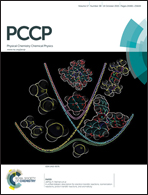The protonation state of thiols in self-assembled monolayers on roughened Ag/Au surfaces and nanoparticles†
Abstract
The protonation state of thiols in self-assembled monolayers (SAMs) on Ag and Au surfaces and nanoparticles (NPs) has been an issue of contestation. It has been recently demonstrated that deuterating the thiol proton produces ostentatious changes in the Raman spectra of thiols and can be used to detect the presence of the thiol functional group. Surface enhanced Raman spectroscopy (SERS) of H/D substituted aliphatic thiols on Ag surfaces clearly shows the presence of S–H vibration between 2150–2200 cm−1 which shifts by 400 cm−1 upon deuteration and a simultaneous >20 cm−1 shift in the C–S vibration of thiol deuteration. Large shifts (>15 cm−1) in the C–S vibration are also observed for alkyl thiol SAMs on Au surfaces. Alternatively, neither the S–H vibration nor the H/D isotope effect on the C–S vibration is observed for alkyl thiol SAMs on Ag/Au NPs. XPS data on Ag/Au surfaces bearing aliphatic thiol SAMs show the presence of both protonated and deprotonated thiols while on Ag/Au NPs only deprotonated thiols are detected. These data suggest that aliphatic thiol SAMs on Au/Ag surfaces are partially protonated whereas they are totally deprotonated on Au/Ag NPs. Aromatic PhSH SAMs on Ag/Au surfaces and Ag/Au NPs do not show these vibrations or H/D shifts as well indicating that the thiols are deprotonated at these interfaces.


 Please wait while we load your content...
Please wait while we load your content...